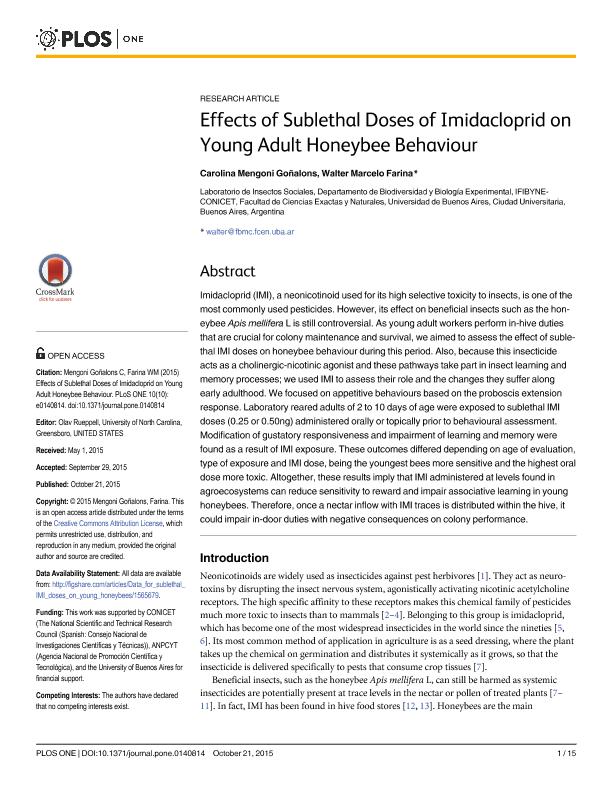Artículo
Effects of Sublethal Doses of Imidacloprid on Young Adult Honeybee Behaviour
Fecha de publicación:
10/2015
Editorial:
Public Library of Science
Revista:
Plos One
ISSN:
1932-6203
Idioma:
Inglés
Tipo de recurso:
Artículo publicado
Clasificación temática:
Resumen
Imidacloprid (IMI), a neonicotinoid used for its high selective toxicity to insects, is one of the most commonly used pesticides. However, its effect on beneficial insects such as the honeybee Apis mellifera L is still controversial. As young adult workers perform in-hive duties that are crucial for colony maintenance and survival, we aimed to assess the effect of sublethal IMI doses on honeybee behaviour during this period. Also, because this insecticide acts as a cholinergic-nicotinic agonist and these pathways take part in insect learning and memory processes; we used IMI to assess their role and the changes they suffer along early adulthood. We focused on appetitive behaviours based on the proboscis extension response. Laboratory reared adults of 2 to 10 days of age were exposed to sublethal IMI doses (0.25 or 0.50ng) administered orally or topically prior to behavioural assessment. Modification of gustatory responsiveness and impairment of learning and memory were found as a result of IMI exposure. These outcomes differed depending on age of evaluation, type of exposure and IMI dose, being the youngest bees more sensitive and the highest oral dose more toxic. Altogether, these results imply that IMI administered at levels found in agroecosystems can reduce sensitivity to reward and impair associative learning in young honeybees. Therefore, once a nectar inflow with IMI traces is distributed within the hive, it could impair in-door duties with negative consequences on colony performance.
Palabras clave:
Honeybee
,
Imidacloprid
,
Learning And Memory
,
Sucrose Sensitivity
Archivos asociados
Licencia
Identificadores
Colecciones
Articulos(IFIBYNE)
Articulos de INST.DE FISIOL., BIOL.MOLECULAR Y NEUROCIENCIAS
Articulos de INST.DE FISIOL., BIOL.MOLECULAR Y NEUROCIENCIAS
Citación
Mengoni Goñalons, Carolina; Farina, Walter Marcelo; Effects of Sublethal Doses of Imidacloprid on Young Adult Honeybee Behaviour; Public Library of Science; Plos One; 10; 10; 10-2015; 1-15; e0140814
Compartir
Altmétricas




